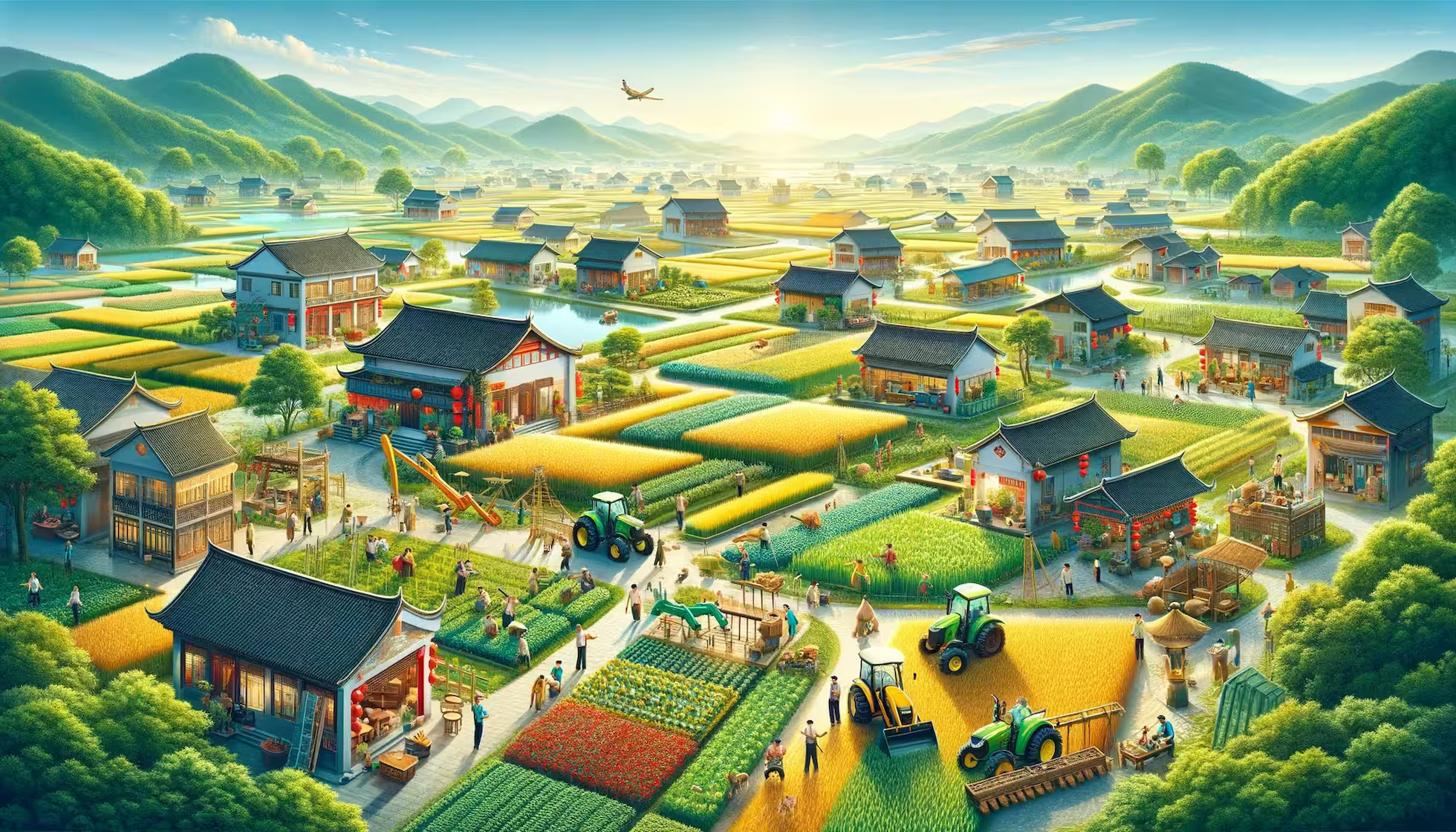Development Trends of Agriculture and Rural Areas in the New Era

1. Comprehensive Upgrading of Chinese Agriculture in the New Era
(1) Grain Production Achieved Another Good Harvest, Supply Security Continues to be Strengthened
Grain production reached a historic high. Significant progress was made in expanding soybean and oil crop planting. Pig production stabilized, with beef, sheep, poultry, milk, and aquatic products all increasing. The supply of fruits and vegetables is sufficient, and prices remain stable.
(2) Strong Employment and Industrial Drive, Poverty Alleviation Achievements Continue to be Consolidated
Monitoring and assistance have been further optimized. Households at risk of falling back into poverty have been fully covered and supported as needed. The industry’s role in poverty alleviation is significant, with over 55% of the central government’s rural revitalization funds used for industrial development. Each county that has lifted itself out of poverty has developed 2-3 specialized leading industries. Nearly three-quarters of the population that has escaped poverty has established close ties with new agricultural business entities. Migrant labor remains stable.
(3) Strong Support from Technology and Equipment, Modern Agriculture Construction Continues to Progress
The seed industry revitalization has been further advanced. Land protection efforts have been intensified. Breakthroughs have been made in the creation of agricultural equipment.
(4) Accelerated Transformation of Production Methods, Continued Advancement of Agricultural Green Transformation
Agricultural non-point source pollution is being coordinated. The ecological environment in key river basins is improving. The supply of green and high-quality agricultural products has increased.
(5) Rural Industries Continue to Grow, and Farmers’ Income Channels Continue to Expand
Agricultural product processing and circulation are developing steadily. New agricultural industries and business models are accelerating. Agricultural employment and entrepreneurship are gaining momentum. The construction of agricultural parks is being upgraded.
(6) Comprehensive Rural Construction, Continuous Improvement in Farmers’ Living Conditions
The rural living environment has been improved. The construction of rural public facilities is progressing in an orderly manner. The effectiveness of rural governance continues to be enhanced.
(7) Expansion and Deepening of Rural Reforms, Continuous Enhancement of Rural Development Momentum
Key reform tasks are progressing steadily. The pilot extension of the second round of land contracts for another 30 years has expanded to 21 provinces. New agricultural business entities are developing and growing. Agricultural product trade is growing rapidly.
2. Comprehensive Progress in Chinese Rural Areas in the New Era
(1) Significant Progress in Rural Land System Reform
The work of confirming, registering, and certifying contracted land rights has been successfully completed. The “three rights” separation system has been initially established. The “Rural Land Contract Law” has been revised and published, and the second round of land contracts has been extended for another 30 years. The pilot program for deepening the reform of the rural homestead system has been implemented. Rural collective operational construction land has entered the market, and the reform of the rural collective land requisition system is being comprehensively and steadily advanced.
(2) Steady Progress in Rural Collective Property Rights System Reform
The work of clearing and verifying rural collective assets has been successfully completed.
(3) Accelerated Construction of a New Agricultural Management System
The family farm cultivation plan and the farmer cooperative standardization improvement action have been implemented. A provincial, municipal, and county-level demonstration creation system has been initially formed.
(4) Further Improvement of the Agricultural Support and Protection System
The strictest farmland protection system has been implemented, the agricultural product price formation mechanism and reserve system have been improved, and the producer subsidy system has been established, yielding positive results.
(5) Significant Results in Rural Governance System Construction
The rural governance system, which combines self-governance, rule of law, and moral governance under the leadership of Party organizations, has been initially established. The grassroots Party organizations’ role as a fighting fortress and the exemplary role of Party members have been fully utilized. The form of villagers’ self-governance has been continuously standardized, the construction of a law-based rural society has been further strengthened, and the management mechanisms and work systems for rural cultural governance have been basically improved.
(6) Solid Progress in Urban-Rural Integrated Development
The equalization of basic public services between urban and rural areas has been steadily promoted. A unified urban and rural basic pension insurance system, a basic medical insurance system, and a major illness insurance system for residents have been established. Over 95% of counties nationwide have passed the national assessment and evaluation of the basic balanced development of compulsory education. Significant progress has been made in the urbanization of the rural migrant population, and the level of equal public employment and entrepreneurship services in urban and rural areas has been significantly improved.
3. Comprehensive Development of Chinese Farmers in the New Era
(1) Actively Cultivating New Professional Farmers
Rural revitalization requires education as a foundation and talent as the key. The development of rural vocational education should promote rural industrial revitalization, accelerate the development of a vocational education system aimed at rural revitalization, and enable more farmers to master the skills needed for agricultural industries through vocational education, allowing them to participate in entrepreneurship and employment, thereby promoting high-quality agricultural development. The “Rural Revitalization Strategy Plan” proposes the comprehensive establishment of a professional farmer system to cultivate a new generation of professional farmers who love agriculture, understand technology, and are good at management, optimizing the structure of agricultural practitioners. The implementation of the new farmer cultivation project supports new professional farmers in participating in secondary and higher agricultural vocational education through flexible schooling. The organization of training should be innovative, exploring field classrooms, online classrooms, and other training methods, supporting farmers’ professional cooperatives, professional and technical associations, leading enterprises, and other entities in providing training. Local governments are encouraged to conduct pilot programs for professional farmer title evaluation. New professional farmers who meet the requirements are encouraged to participate in urban employee pension and medical insurance systems.
(2) Strengthening the Rural Employment Service System
- Strengthen the construction of grassroots platforms in townships and administrative villages, expand the coverage of employment services, and improve service levels.
- Conduct rural labor resource surveys and statistics, establish a rural labor resource database, and manage it dynamically.
- Accelerate the informatization of public employment services and create an integrated online and offline service model.
- Promote the establishment of a vocational skills training system that covers all urban and rural workers, runs through the lifetime of workers’ learning and work, and meets the needs of employment and talent development, enhancing the pertinence and effectiveness of professional training.
- On the basis of resource integration, rationally plan and build a number of public training bases.
(3) Expanding Employment Channels for Rural Labor Transfer
Enhance the ability of economic development to create jobs, expand employment channels for rural labor transfer, guide rural labor to work outside their hometowns, and more actively support local and nearby employment. Continuously increasing farmers’ incomes is a strong driving force for the transformation of modern farmers. It is necessary to develop and strengthen the county economy, accelerate the cultivation of regional characteristic industries, and expand employment opportunities for farmers. Actively develop industries and enterprises with strong employment absorption capacity, and rationally guide the gradient transfer of industries in conjunction with the construction of new-type urbanization. Create more opportunities for rural labor to transfer to employment, and promote the construction of rural labor employment demonstration bases. Strengthen labor cooperation and actively carry out organized labor export. Implement the rural employment promotion action, vigorously develop rural characteristic industries, promote the diversification of the rural economy, and provide more employment opportunities. In combination with rural infrastructure and other construction projects, encourage the use of work-for-relief methods to absorb rural labor for local employment. The development of rural jobs is needed, continuously optimizing the rural industrial structure, and accelerating the integration of primary, secondary, and tertiary industries in rural areas. Encourage the establishment of environmentally friendly and labor-intensive enterprises in rural areas. Develop rural characteristic industries, revitalize traditional crafts, and cultivate a number of family workshops, handicraft workshops, and rural workshops.
(4) Cultivating and Expanding Local Innovation and Entrepreneurship Groups
Promote the cooperation of industry, academia, and research, strengthen the collaboration of scientific research institutions, universities, enterprises, and returning personnel, and promote the diversification of rural innovation and entrepreneurship groups. Cultivate agricultural industry technology innovation alliances led by enterprises, accelerate the diffusion of funds, technology, and services, and drive and support returning entrepreneurs to develop businesses relying on the industrial chain. Integrate resources from the government, enterprises, and society, and promote the gathering of various elements such as policies, technology, and capital towards rural innovation and entrepreneurship. Encourage farmers to start businesses locally, return home to start businesses, and increase the support of various resources for local farmers to start businesses. Deepen the implementation of the science and technology commissioner system, and guide modern production factors such as technology, information, funds, and management to gather in rural areas.
(5) Encouraging Social Talents to Engage in Rural Construction
While cultivating and expanding local innovation and entrepreneurship groups, it is necessary to establish and improve incentive mechanisms, study and formulate relevant policies and management measures, and encourage social talents to engage in rural construction. Implement and improve support policies such as financing loans, infrastructure construction subsidies, and tax and fee reductions, and guide industrial and commercial capital to actively invest in rural revitalization. Continue to implement the “Three Regions” talent support plan, further promote the work of college graduates as village officials, and implement programs such as “Three Support and One Assistance” and grassroots growth plans for college graduates based on local conditions, and carry out “Women’s Action for Rural Revitalization” and “Youth Contribution Action”. Establish cooperation and exchange mechanisms for talent cultivation between urban and rural areas, regions, and schools and localities. Establish a regular service mechanism for urban doctors, teachers, and science and culture personnel to serve rural areas.
Published at: Feb 26, 2024 · Modified at: Dec 11, 2025


